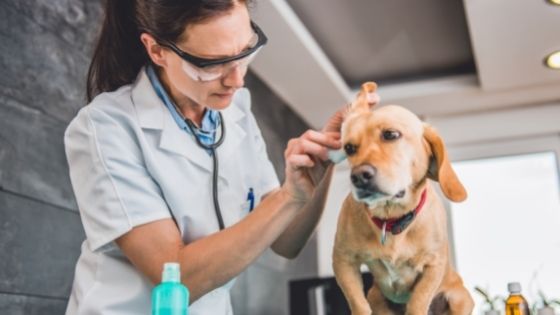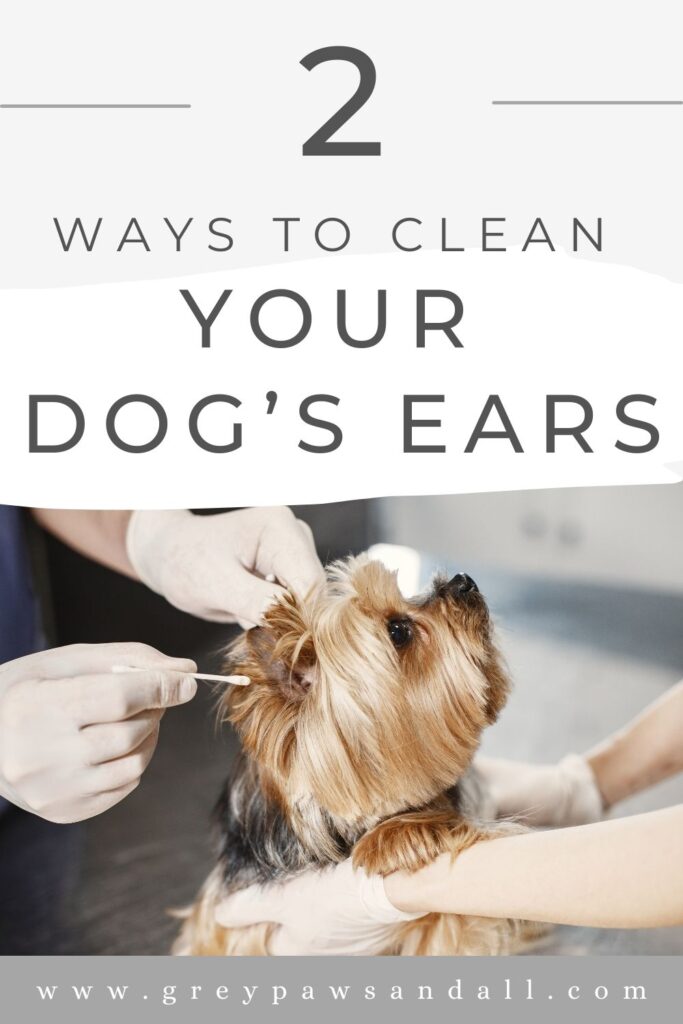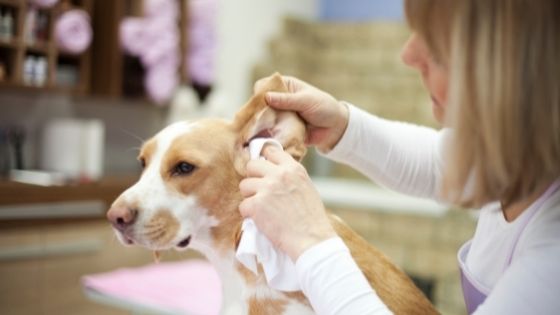Does your dog put up a fuss when you touch his ears? That’s not uncommon, especially if he or she was not socialized to touch when younger.
Before you jump straight into cleaning your dog’s ears, he needs to get used to having them touched. Spend time every day gently petting him, including his ears. If he really doesn’t like it, do it for a quick second then move on, or get as close as you can without him being uncomfortable. Try giving him treats with one hand while you pet him with the other. Start off with a short two-minute session, and see how it goes. If he’s okay, increase the time a little bit each day.
*There are affiliate links in this post, which means if you buy something I may receive a small commission. This has no effect on the price you pay, but will help me continue bringing you helpful content.*
Why Your Dog Hates Having His Ears Touched
- A dog’s ears can be quite sensitive, so if he’s not used to it he may not like it
- Firm handling in the past could have been quite uncomfortable, and now he’s wary
- Kids may have pulled his ears, and now there’s a negative association
- Inflammation and infections are painful conditions, so it’s understandable if he’ll be anxious about having anyone near them
- Your dog is blind and gets startled when he suddenly feels someone touching him
Should You Clean Your Dog’s Ears?
Allowing wax and oil to build up in a dog’s ears can make them prone to infections, so ear cleaning as part of a regular grooming routine is a good idea. It becomes a problem when they are cleaned too often.
If your dog is anxious about having his ears cleaned, that can manifest as aggression. The most important thing is making sure you’re safe, so you may need to use a muzzle or have the vet do it until he gets used to having his ears touched. It’s also possible his reaction is due to an ear infection, and he’s in pain.
How Often Should You Clean Your Dog’s Ears?
There are no hard and fast rules when it comes to frequency. It will depend on the type of dog you have, their activities and if/how often they get infections.
Some vets recommend once a month, others once every couple of months. Breeds with long ears like a Bassett Hound for instance or those that like to swim, should have their ears cleaned more frequently, perhaps every week or every second week.
The best thing to do is speak to your vet, and follow his or her recommendation for your dog.
What to Use to Clean Your Dog’s Ears
You’ll need cotton balls or gauze, syringe (just in case, depending on type of cleaner), a towel and of course lots of treats! Q-tips made for humans should never be used, as they can push the wax and debris further into the ear canal, damaging the ear drum.
Cleaners come in liquid or wipes, some with more natural ingredients than others.
There are so many products to choose from, it can be challenging deciding on the best one for your dogs. I recommend doing your research, and when you find products you like the sound of, ask your vet what he thinks.
Here are a few ear cleaners that come highly recommended by senior dog parents in my FB group:
• Vetricyn Ear Cleaner
• K9 Ear Solutions by Liquid Health
• A lot of people who have cocker spaniels recommend Zim’s cocker ear cleaner recipe

Make Your Own Ear Cleaner
The recipes below come from an article called “A DIY Dog Ear Cleaner Using Simple Ingredients”
Natural Oils
To stop wax build up, add a couple of drops of olive, almond, and mineral oils to the outside of your dog’s ear canal. When your dog shakes his head, the oil will spread around the canal. If he doesn’t, massage the ears to help spread the oil. Use a cloth or cotton ball to remove the oil and any wax you see.
Hydrogen Peroxide
Mix one part 3% hydrogen peroxide with one part water. Pour the mixture into a bulb ear syringe, flush your dog’s ears with the solution and wipe away any leftover solution.
NOTE: This could be harmful in certain situations because it kills the bacteria that cause an infection but sometimes kills the good as well. Water can also remain in the ear canal, creating a breeding ground for any bacteria left over after cleaning. It’s best to speak to your vet first.
Vinegar
Pour 2oz of white vinegar into a glass. Add ½ teaspoon of boric acid and a few drops of rubbing alcohol and iodine, and mix well. Dip a cotton ball in until it’s thoroughly soaked. Gently wipe the outer portion of your dog’s ear, then wipe with a damp washcloth.
NOTE: Please do not use vinegar if your dog has an ear infection.
NOTE: Please speak to your vet before trying any of these recipes.
How to Clean a Senior Dog’s Ears
If you’ve recently decided to start cleaning your dog’s ears but there’s no health issue and no rush, I recommend spending time getting him used to having his ears touched, and making it a relaxed and even enjoyable experience.
Getting Your Dog Used to Having His Ears Touched
Top tip: Try this after a walk or good exercise session so he’ll be tired and relaxed.
Top tip: Don’t let him see you go to the cupboard to get the cleanser. Dogs are so smart, and they’ll run when they know what you’re about to do. Hiding it in your hand instead of approaching him with a bottle he can see also helps. Yes, I speak from experience!!
I don’t know if you can get near your dog’s ears or not, so for the sake of this exercise I’ll assume not.
• Play dog calming music, something like Through a Dog’s Ear for example, or one of the many other dog calming selections on Youtube. Sit together on the couch, bed or floor and gently pet him over his entire body, being sure to include his head and ears, or as close to them as you can get. Practice this daily, as it’s not only a great way to get him used to having his ears touched, it’s also a wonderful bonding experience.
• Each time you practice, try and pet his ears longer and on different areas. Don’t forget to touch the inside of his ears as well, since that’s where you’ll be cleaning. Sometimes use your fingers, other times a cotton ball or cotton pad.
• Want to take this to the next level? Have some of your dog’s favorite treats within easy reach, and while you’re petting him with one hand, feed him with the other!
Now that your dog is comfortable having his ears touched, it’s time to check out the step-by-step instructions for cleaning.
Step by Step Guide to Ear Cleaning
• Wash your hands or wear gloves
• Pick a good spot – lots of light, quiet, maybe a tile floor instead of carpet, a bathroom so he can’t run too far…
• Make sure you have everything you need laid out, easily accessible and ready to use – cotton balls/pads or gauze pad, cleaning solution, syringe, towel and treats.
• Choose a calm moment when he’s tired, like after a walk or play session for example.
• Play dog calming music, you’ll find a huge selection on Youtube
• Make sure you have plenty of time, you don’t want to rush this
• I recommend you have two people, at least at the beginning. One can do the actual cleaning, while the other reassures the dog and gives the treats.
•If your dog is struggling, fidgeting, uncomfortable or showing any sign he doesn’t want this, stop immediately. You should never force this on your dog. If you aren’t able to do it on your own, it’s perfectly okay. Have your vet or vet nurse do it, and show you how.
Method One
• Sit on the floor and position your dog in a way that makes it comfortable for him, and easy for you to reach his ears. Maybe have him sit between your legs with his butt facing you?
• With your thumb and forefinger, lift his ear and look inside. Check for redness/inflammation, discharge or a bad smell. If you see anything like this, stop before you start and call the vet. If all looks good, use your other hand to gently wipe around the opening of the ear with a damp cotton ball or pad. Insert the tip of the bottle into his ear, squeeze out the recommended amount, then massage the base of the ear to help the cleaner get into the ear canal. Don’t let the bottle touch his ear, if it does wipe the top in alcohol to stop any bacteria or yeast.
• While still holding up the ear flap, wipe away any gunk coming out with a new cotton ball, cotton pad or gauze.
• If your dog shakes his head, it will help the rest of the cleaner and debris come out. Once again, remove with cotton ball or gauze.
• Repeat for his other ear.
NOTE: If at any time he’s uncomfortable, stop and call your vet. He may have something going on you couldn’t see.
Method Two
It’s the same as method one, only this time instead of squeezing the solution directly into your dog’s ear, squeeze it onto a cotton ball, pad or gauze wrapped around your finger. Gently clean the outside than the inside of the ear. Be careful not to go too deep. Use another cotton pad to clear out the remaining wax and debris.
How Long Until Your Dog Likes Having His Ears Cleaned?
That depends on your dog’s anxiety level, and how often you’re practicing the steps mentioned above. A few days may be all he needs, or if he’s really anxious he may need a few weeks, and that’s okay. Nothing can be gained from rushing it.
Signs Your Dog Probably Has an Ear Infection
We talked about how to get your dog used to having his ears touched and how to clean them, but what if your dog has an infection? These signs are pretty good indications he does:
- Head tilting
- Head shaking
- Scratching/pawing or rubbing his ears
- Ears feel hot to the touch
- Foul odor around or in the ear
- Discharge from the ear
- Swelling, redness of the ear canal
In severe cases your dog may experience hearing loss, and even lose interest or have difficulty in eating or drinking
If infection is likely, skip the cleaning and call your vet right away. Left untreated an ear infection can cause damage, include hearing loss.
Since an infection is painful, it may be best to have your vet do the cleaning, at least until it’s sufficiently healed and there’s no pain. If you aren’t able to bring him every day, perhaps there is an alternative treatment.

How to Treat Ear Infections in a Dog
You will have gotten the appropriate medication and advice from your vet, but some people like to go a more natural route. Here are some suggestions from Dogs Naturally Magazine to ask your vet about. Don’t try anything without approval!
Green Tea
Add two green tea bags to 8oz of boiling water, and steep for a few minutes. When cool, syringe into your dog’s ear(s).
Calendula Tincture
Add 5-10 drops of calendula tincture to 1 cup of filtered lukewarm water, then put in ears using a dropper.
Grapefruit Seed Extract
Mix 10 drops of grapefruit seed extract with ½ oz of pure aloe vera juice.
Oil Of Oregano
Add one drop to ½ oz of warm pure aloe vera juice. Clean the visible parts of the ear with a cotton ball soaked in the mixture.
How To Give Your Dog Ear Medication
You would use the same method as described in the section about cleaning your dog’s ears.
Are you able to clean your senior dog’s ears? What tips do you have to offer? Sharing helps others, so leave your awesome advice below.
If you’re looking for a community of senior dog parents, a place where you can find helpful tips, support and people who “get it” please join my FB group Senior Dog Care Club
I help senior dog parents struggling with anticipatory grief and quality of life issues by offering practical tips, advice and one on one support. I am also a Pet Loss Bereavement Specialist, helping you navigate through your pet loss journey.
Visit my services page to book a FREE 20 minute discovery call, or email me (Hindy) at hpearson141@gmail.com if you have any questions.
I’ve been rescuing and caring for senior dogs since 2009. From vision and hearing loss to obesity, dementia, kidney disease, liver issues, cardiac problems, Cushing’s, mobility challenges and more, you could say I’ve dealt with and learned a lot! In addition to my hands on experience, I’ve taken many courses and earned several qualifications to keep learning how to help senior dogs and they include: Senior Dog Enrichment, Understanding Canine Anxiety, Care of the Senior Pet and I’m a Certified Pet Loss Specialist.

